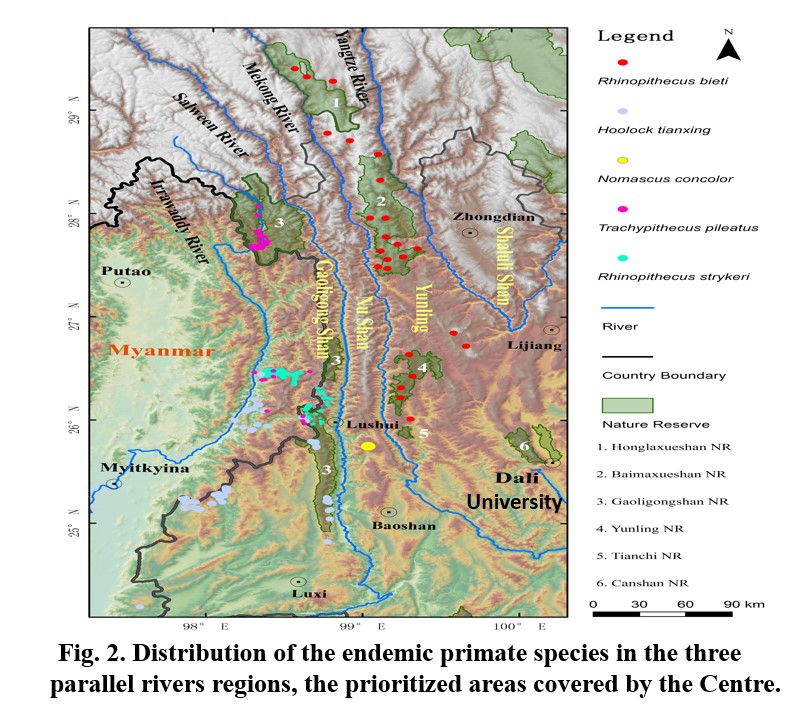Initiating project
Initiating project
 We plan to begin by focusing on a region that has played an unprecedented role in the evolution of Asian nonhuman and human primates since the Quaternary. This region contains three-mountain ranges that are divided by the three longest rivers in Asia (Fig. 2):
We plan to begin by focusing on a region that has played an unprecedented role in the evolution of Asian nonhuman and human primates since the Quaternary. This region contains three-mountain ranges that are divided by the three longest rivers in Asia (Fig. 2):- Gaoligongshan, divided by the Irrawaddy and Salween rivers, is part of the main ridge forming a natural boundary between China and Myanmar. This is a national nature reserve composed of three zones, where two highly threatened primate species are present, the Critically Endangered black/Myanmar snub-nosed monkey (Rhinopithecus strykeri), which has a remaining wild population in China of only 200 individuals plus 200 additional individuals in Myanmar, and the Endangered Shortridge’s capped langur (Trachypithecus shortridgei) in the north section, which has an estimated population of 250-370 individuals remaining in China. The behavior, ecology, and biology of both species are poorly understood.
- Nushan (Biluaoxueshan), situated between the Salween and Mekong rivers, is the narrowest and steepest mountain in the range. This mountain range is located between known ranges of two species of snub-nosed monkeys (R. strykeri and R. bieti) and it remains unclear whether either, both, or neither species is present in this area. There is no national nature reserve in this area. Therefore, it is a priority to initiate preliminary fieldwork and population censuses to identify species demography and distributions to develop a proposal for the creation of a national nature reserve.
- Yunling is divided by the Mekong and Yangtze rivers, and represents the only known distribution for the Endangered R. bieti (the black and white sub-nosed monkey). Although three national nature reserves (Honglaxueshan, Baimaxueshan and Tianchi) and one provincial reserve (Yunling) are present in the region, the population demography and species distributions of many animal and plant species in the region are poorly documented. Recommendations for protecting and increasing the remaining population of R. bieti include habitat restoration and the creation of forested or protected corridors linking different reserves that have been set up in recent years to mitigate the accelerated forest fragmentation and connect isolated subpopulations.
- There are several additional Critically Endangered primate species in the region, such as the skywalker hoolock gibbon (Hoolock tianxing), the western black-crested gibbon (Nomascus concolor), and the northern pig-tailed macaque (Macaca leonine). For many of these species only limited data exist on their behavior and ecology.
Research initiatives of the Centre will also prioritize studies on other Critically Endangered vertebrate species, such as the Yangtze sturgeon (Acipenser dabryanus), Chinese sturgeon (Acipenser sinensis), Asian golden cat (Catopuma temminckii), barbless carp (Cyprinus pellegrini), white-trumped vulture (Gyps bengalensis), Chinese pangolin (Manis pentadactyla), forest musk deer (Moschus berezovskii), Alpine musk deer (Moschus chrysogaster sifanicus), black musk deer (Moschus fuscus), Przewalski's gazelle (Procapra przewalskii), snow trout (Schizothorax taliensis) and golden lined fish (Sinocyclocheilus graham). In the future we also hope to develop studies on 17 Endangered vertebrate species (IUCN 2019).
Therefore, the Centre’s focus for successful conservation and research is to bring together expert scholars and conservationists from all over the world to work collaboratively with large and varied data sets to develop strategies, policies, and management tools, in conjunction with local governments, business leaders, NGOs, and global citizens to conserve and protect animal species and their environments.